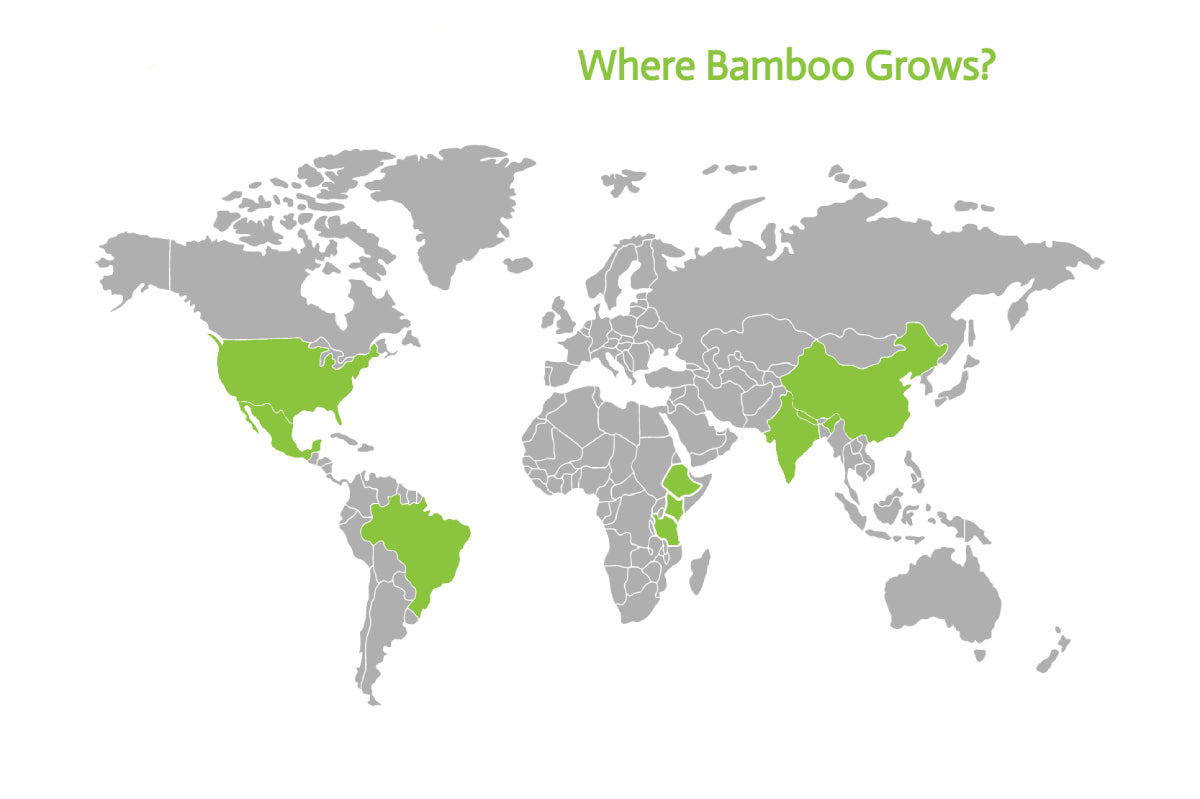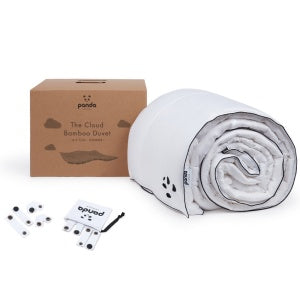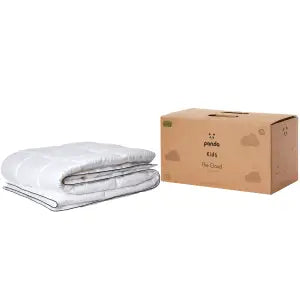
Wonderful Roots: Discover all about where bamboo grows
Where does bamboo grow?
From the luscious forests of Southeast Asia to the cold depths of the Himalayas, bamboo can grow in many climates and conditions. However, most bamboo species ' natural habitat is warm and tropical. Bamboo forests are commonly found and harvested in Asia, Africa, North and South America and Australia. These continents provide the high humidity in which bamboo can thrive. Bamboo is notoriously known for relying on very little more than water and sunshine to grow, making it pretty easy for it to lay down its roots anywhere. Certain species can withstand colder regions and have been spotted growing in areas of up to -20 degrees. It’s true, bamboo is made of pretty strong stuff! No wonder it makes such incredibly durable products.

![[MattressTopper] Panda London Memory Foam Bamboo Mattress Topper package box](http://pandalondon.com/cdn/shop/files/Bamboo_Mattress_Topper_Package_Box.webp?v=1742301823&width=1500)
![[MattressTopper] Panda London Memory Foam Bamboo Mattress Topper on the floor](http://pandalondon.com/cdn/shop/products/Panda-Memory-Foam-Bamboo-Mattress-Topper-Yoga-e1624045454555.jpg?v=1758795458&width=1000)
![[MattressTopper] Bamboo Mattress Topper Lifestyle Image with Memory Foam Pillows Product Page](http://pandalondon.com/cdn/shop/files/Bamboo_Mattress_Topper_Lifestyle_Image_with_Memory_Foam_Pillows_Product_Page.webp?v=1758795458&width=800)
![[MattressTopper] Bamboo Mattress Topper Lifestyle Image with Bamboo Pillows In the Garden room Product Page](http://pandalondon.com/cdn/shop/files/Bamboo_Mattress_Topper_Lifestyle_Image_with_Bamboo_Pillows_In_the_Garden_room_Product_Page.webp?v=1758795458&width=800)
![[MattressTopper] Panda London Memory Foam Bamboo Mattress Topper side](http://pandalondon.com/cdn/shop/files/Mattress_Topper_Isolated_-_resized.jpg?v=1758795458&width=800)
![[HybridMattressPro] Main Image for Hybrid Bamboo Mattress Pro with all awards](http://pandalondon.com/cdn/shop/files/Hybrid_Bamboo_Mattress_Pro_Main_product_Image_with_awards.webp?v=1753971649&width=1000)
![[HybridMattressPro] Breathable Hybrid Bamboo Mattress](http://pandalondon.com/cdn/shop/products/Breathable-Hybrid-Bamboo-Mattress.jpg?v=1753971649&width=1920)
![[HybridMattressPro] Hybrid Bamboo Mattress Pro Cover Zip](http://pandalondon.com/cdn/shop/files/Hybrid_Bamboo_Mattress_Cover.jpg?v=1753971649&width=800)
![[HybridMattressPro] Panda Hybrid Bamboo Mattress Pro](http://pandalondon.com/cdn/shop/files/Hybrid_Bambo_Memory_Foam_Mattress_-_BioCell_Foam_x.jpg?v=1755095108&width=800)
![[HybridMattressPro] Couple on a Hybrid Bamboo Mattress Pro](http://pandalondon.com/cdn/shop/files/Hybrid_Bamboo_Mattress_Couple.jpg?v=1753971649&width=800)
![[CloudDuvet] Panda London The Cloud Bamboo Duvet Packaging](http://pandalondon.com/cdn/shop/products/Panda-London-The-Cloud-Bamboo-Duvet-Panda-Life-scaled_00a651ad-4ca3-4105-b520-12a94c1a4f71.jpg?v=1713363286&width=1920)
![[CloudDuvet] Panda London The Cloud Bamboo Duvet Rolled](http://pandalondon.com/cdn/shop/products/Duvet-Listing-Images03.jpg?v=1764079307&width=1000)
![[CloudDuvet] Panda London The Cloud Bamboo Duvet Girl Huggin a Duvet on the Bed](http://pandalondon.com/cdn/shop/files/Cloud_Bamboo_Duvet_-_Lady_Hugging_it_on_Bed_LifestyleImage.jpg?v=1764079307&width=1000)
![[CloudDuvet] Panda London The Cloud Bamboo Duvet Guy In the Air with Cloud Bamboo Duvet](http://pandalondon.com/cdn/shop/files/GuyonaHybridBambooMattresswithCloudDuvet.jpg?v=1764079307&width=2000)
![[CloudDuvet] Panda Cloud Duvet Winter on the bed lifestyle image](http://pandalondon.com/cdn/shop/files/Panda_Cloud_Duvet_Winter_on_the_Bed_Lifestyle-1_image.jpg?v=1764079307&width=1000)
![[BBWhite] White 100% Bamboo Bedding](http://pandalondon.com/cdn/shop/files/Pure_White_Full_Bed.webp?v=1719581797&width=1000)
![[BBWhite] White 100% Bamboo Bedding Texture](http://pandalondon.com/cdn/shop/files/100_Bamboo_Bedding_-_Pure_White_-_Close_Up_02.webp?v=1762879591&width=1000)
![[BBWhite] White 100% Bamboo Bedding Woman in bed sleeping](http://pandalondon.com/cdn/shop/files/100-Bamboo-Bedding-Set-Pure-White-BB.webp?v=1762879591&width=768)
![[BBWhite] White 100% Bamboo Bedding Woman Duvet cover buttons](http://pandalondon.com/cdn/shop/files/hand_and_buttons_1.webp?v=1762879591&width=1000)
![[BBWhite] White 100% Bamboo Bedding Woman in bed looking and smiling-](http://pandalondon.com/cdn/shop/files/SatonMadeBed-White100_BambooBedding-white_-_BB_SideShot1000x1000.webp?v=1762879591&width=980)
![[BBUrbanGrey] Urban Grey 100% Bamboo Bedding](http://pandalondon.com/cdn/shop/files/Made_Bed_-_Urban_Grey_-_Wide_Shot_2_1_1.webp?v=1762880019&width=1000)
![[BBUrbanGrey] Cloud Duvet Urban Grey 100% Bamboo Bedding Set](http://pandalondon.com/cdn/shop/files/Cloud_Duvet_-_Grey_-_Close_up_2.webp?v=1762880019&width=1000)
![[BBUrbanGrey] Urban Grey 100% Bamboo Bedding Set Woman sitting on the bed](http://pandalondon.com/cdn/shop/files/Sat_in_Bed_-_Grey_100__Bamboo_Bedding_-_Wide_Shot.webp?v=1762880019&width=1000)
![[BBUrbanGrey] Urban Grey 100% Bamboo Bedding Set Woman Duvet buttons Panda London](http://pandalondon.com/cdn/shop/files/hand_buttons_grey_bedding_1.webp?v=1762880019&width=1000)
![[BBUrbanGrey] Woman Sitting on the Bamboo Bedding with coffee](http://pandalondon.com/cdn/shop/files/SatonMadeBed-White100_BambooBedding-SideShot1000x1000.jpg?v=1762880019&width=1000)
![[BBNavyBlue] Deep Sea Navy Blue 100% Bamboo Bedding](http://pandalondon.com/cdn/shop/files/Made_Bed_-_Navy_-_Wide_Shot_3_copy.webp?v=1762879591&width=1000)
![[BBNavyBlue] Deep Sea Navy Blue 100% Bamboo Bedding Texture](http://pandalondon.com/cdn/shop/files/Cloud_Duvet_-_Navy_-_Close_up_2.webp?v=1762880019&width=1000)
![[BBNavyBlue] Deep Sea Navy Blue 100% Bamboo Bedding Woman Sitting on the bed](http://pandalondon.com/cdn/shop/files/Sat_Up_in_Bed_-_Navy_100__Bamboo_Bedding_-_Hands_on_Bed.webp?v=1762880019&width=1000)
![[BBNavyBlue] Deep Sea Navy Blue 100% Bamboo Bedding Duvet Cover Buttons](http://pandalondon.com/cdn/shop/files/Cloud_Duvet_Cover_Buttons_-_Deep_Sea_Navy.webp?v=1762880019&width=1000)
![[BBNavyBlue] Deep Sea Navy Blue 100% Bamboo Bedding Woman sitting on the bed looking away](http://pandalondon.com/cdn/shop/files/SatonMadeBed-White100_BambooBedding-SideShot1000x1000-001.webp?v=1762880019&width=980)
![[BBPink] Vintage Pink Blue 100% Bamboo Bedding](http://pandalondon.com/cdn/shop/files/Made_Bed_-_Pink_-_Wide_Shot_copy.webp?v=1762879591&width=1000)
![[BBPink] Vintage Pink Texture 100% Bamboo Bedding](http://pandalondon.com/cdn/shop/files/Cloud_Duvet_-_Pink_-_Close_up_2.webp?v=1762880019&width=1000)
![[BBPink] Vintage Pink Woman Sitting on the 100% Bamboo Bedding](http://pandalondon.com/cdn/shop/files/Sat_Up_in_Bed_-_Pink_-_Hands_on_Bed.webp?v=1762880019&width=1000)
![[BBPink] Vintage Pink Woman Sitting on the 100% Bamboo Bedding Duvet Cover](http://pandalondon.com/cdn/shop/files/Cloud_Duvet_Cover_Buttons_-_Vintage_Pink.webp?v=1762880019&width=1000)
![[BBPink] Vintage Pink Woman Sitting on the 100% Bamboo Bedding Woman looking far away](http://pandalondon.com/cdn/shop/files/SatonMadeBed-White100_BambooBedding-SideShot1000x1000-001_Vintage_Pink.webp?v=1762880019&width=980)
![[BBGrey] Light Grey 100% Bamboo Bedding](http://pandalondon.com/cdn/shop/files/Made_Bedding_in_Bedroom_-_Urban_Grey_-_Wide_Shot.webp?v=1762879591&width=1000)
![[BBGrey] Light Grey 100% Bamboo Bedding texture](http://pandalondon.com/cdn/shop/files/Texture17.webp?v=1762880019&width=1000)
![[BBGrey] Light Grey 100% Bamboo Bedding with Woman smiling](http://pandalondon.com/cdn/shop/files/Sat_Up_in_Bed_-_Grey_-_Hands_on_Bed.webp?v=1762880019&width=1000)
![[BBGrey] Light Grey 100% Bamboo Bedding with Duvet Cover buttons](http://pandalondon.com/cdn/shop/files/Cloud_Duvet_Cover_Buttons_-_Quiet_Grey.webp?v=1762880019&width=1000)
![[BBGrey] Light Grey 100% Bamboo Bedding with Woman smiling and sitting coffee](http://pandalondon.com/cdn/shop/files/SatonMadeBed-White100_BambooBedding-SideShot1000x1000-002-_Grey.webp?v=1762880019&width=980)
 Hybrid Bambuskissen
Hybrid Bambuskissen Memory Foam Bambuskissen
Memory Foam Bambuskissen Memory Foam Bambuskissen für Kinder
Memory Foam Bambuskissen für Kinder Baby Memory Foam Bambuskissen
Baby Memory Foam Bambuskissen Panda Bettdecke Cloud
Panda Bettdecke Cloud Sommerbettdecke aus Bambus
Sommerbettdecke aus Bambus Kinder Cloud Bettdecke
Kinder Cloud Bettdecke

![[all] Bamboo Mattress Protector Package - PandaLondon](http://pandalondon.com/cdn/shop/files/Bamboo_Mattress_Protector_-_Packaging_Image_-_White_Background.webp?v=1721139172&width=1900)
![[all] Bamboo Mattress Protector for Hybrid Bamboo Mattress](http://pandalondon.com/cdn/shop/files/Bamboo_Mattress_Protector_New.webp?v=1721138562&width=1000)
![[all] Book on a Bamboo Mattress Protector](http://pandalondon.com/cdn/shop/products/Mattress-Protector-Listing-Images02.jpg?v=1721139189&width=1500)
![[all] Bamboo Mattress Protector Corner](http://pandalondon.com/cdn/shop/products/Mattress-Protector-Listing-Images03-e1623787734812.jpg?v=1721139189&width=1300)
![[all] Bamboo Mattress Protector Corner in line Panda London](http://pandalondon.com/cdn/shop/products/Mattress-Protector-Listing-Images04.jpg?v=1721139183&width=1500)
![[all] Panda Bamboo Mattress Protector Panda London](http://pandalondon.com/cdn/shop/files/Panda-Bamboo-Mattress-Protector-Guarantee-768x768_jpg_450393f5-91a9-499f-b15a-12d636a9a8b7.webp?v=1721139183&width=768)
![[KidsDuvet] Kids Cloud Duvet product image](http://pandalondon.com/cdn/shop/products/Panda-London_Kids_Duvet-scaled.jpg?v=1713363289&width=1920)
![[KidsDuvet] Kids Cloud Duvet on a cotbed](http://pandalondon.com/cdn/shop/files/Kids-KidsCloudDuvet.jpg?v=1750342405&width=2000)
![[KidsDuvet] Kids Cloud Bamboo Duvet Folded](http://pandalondon.com/cdn/shop/files/Kids_Cloud_Bamboo_Duvet_-_Folded_-_Logo_Shown_-_White_Background_Kids_Duvet.jpg?v=1750342405&width=1000)
![[KidsDuvet] Kids_CloudBambooDuvet-CornerLip-WhiteBackground](http://pandalondon.com/cdn/shop/files/Kids_CloudBambooDuvet-CornerLip-WhiteBackground.jpg?v=1750342405&width=2000)
![[KidsDuvet] Kids_Cloud_Bamboo_Duvet_-_Padded_-_Close_Up_Shot_Kids](http://pandalondon.com/cdn/shop/files/Kids_Cloud_Bamboo_Duvet_-_Padded_-_Close_Up_Shot_Kids.jpg?v=1750342405&width=1000)
![[KidsDuvet] Kids_CloudBambooDuvetRolled-WhiteBackground_1](http://pandalondon.com/cdn/shop/files/Kids_CloudBambooDuvetRolled-WhiteBackground_1.jpg?crop=region&crop_height=1697&crop_left=151&crop_top=0&crop_width=1697&v=1750342405&width=2000)
![[KidsDuvetUKSingle] UK_Single_kids_-_Summer_Cloud_Duvet_Main_Image](http://pandalondon.com/cdn/shop/files/UK_Single_kids_-_Summer_Cloud_Duvet_Main_Image.webp?v=1750342648&width=1000)
![[KidsDuvetUKSingle] UK_Single_Kids-Image_Summer_Bamboo_Duvet_Lifestyle_image-1](http://pandalondon.com/cdn/shop/files/UK_Single_Kids-Image_Summer_Bamboo_Duvet_Lifestyle_image-1.webp?v=1750342794&width=1000)
![[KidsDuvetUKSingle]UK_Single_Summer_Duvet_-_Duvet_Folded_Isolated-webp](http://pandalondon.com/cdn/shop/files/UK_Single_Summer_Duvet_-_Duvet_Folded_Isolated-webp.webp?v=1750342794&width=1000)
![[KidsDuvetUKSingle] UK_Single_Summer_Duvet_-_Snuggle_Snaps_Bag_02-webp](http://pandalondon.com/cdn/shop/files/UK_Single_Summer_Duvet_-_Snuggle_Snaps_Bag_02-webp.webp?v=1750343051&width=1000)
![[KidsDuvetUKSingle] UK_Single_Kids_-_Summer_Cloud_Snuggle_Snaps_Image_Webp](http://pandalondon.com/cdn/shop/files/UK_Single_Kids_-_Summer_Cloud_Snuggle_Snaps_Image_Webp.webp?v=1764079307&width=1500)
![[KidsDuvetAllSeason] Kids Duvet UK Single 10.5 tog rating all season one](http://pandalondon.com/cdn/shop/files/Kids_All_Seasn_10.5_Tog_Panda_Cloud_Duvet_Main_Image.jpg?v=1750685858&width=1920)
![[KidsDuvetAllSeason] Texture Duvet Cloud Panda](http://pandalondon.com/cdn/shop/files/Kids_All_Season_Panda_Cloud_Bamboo_Duvet_-_Padded_-_Close_Up_Shot.jpg?crop=region&crop_height=1900&crop_left=169&crop_top=0&crop_width=1900&v=1750686755&width=2239)
![[KidsDuvetAllSeason] Rolled Duvet All Season 10.5 tog](http://pandalondon.com/cdn/shop/files/Kids_All_Season_Duvet_Image_002_Panda_Cloud_Duvet.jpg?v=1750686755&width=1000)
![[KidsDuvetAllSeason] Panda Cloud Duvet Corner](http://pandalondon.com/cdn/shop/files/Kids_All_Season_Panda_Cloud_Cloud_Bamboo_Duvet_-_Corner_Lip_-_White_Background.jpg?v=1750686755&width=4848)
![[KidsDuvetAllSeason] All season Panda Cloud Duvet](http://pandalondon.com/cdn/shop/files/Kids_All_Season_Duvet_UK_Single_Kids-Image_Summer_Bamboo_Duvet_Lifestyle_image-1_webp.jpg?v=1750686755&width=1000)
![[BambooAndFrenchLinenFSGrey] Bamboo and French Linen Fitted Sheets Panda London Silver Light Grey Earth Collection](http://pandalondon.com/cdn/shop/files/Bamboo-and-French-Linen-Fitted-Sheet-Silver-Lining-Grey-jpg.jpg?v=1734454242&width=1500)
![[BambooAndFrenchLinenFSGrey] Bamboo and French Linen Fitted Sheets Panda London Silver Light Grey Lifestyle Image](http://pandalondon.com/cdn/shop/files/Silver_Linning_Grey_-_French_linen_Fitted_Sheets.webp?v=1734454242&width=980)
![[BambooAndFrenchLinenFSGrey] Bamboo and French Linen Fitted Sheets Panda London Silver Light Grey Texture](http://pandalondon.com/cdn/shop/files/Silver_Linning_Grey_-_French_linen_Fitted_Sheets_Texture.webp?v=1734454242&width=980)
![[BambooAndFrenchLinenFSNatural] Bamboo and French Linen Fitted Sheets Panda London Natural Earth Collection](http://pandalondon.com/cdn/shop/files/Bamboo-and-French-Linen-Fitted-Sheet-Natural-jpg.jpg?v=1734454242&width=1500)
![[BambooAndFrenchLinenFSNatural] Bamboo and French Linen Fitted Sheets Panda London Natural Lifestyle Image](http://pandalondon.com/cdn/shop/files/Natural_-_French_Linen_Fitted_Sheets.webp?v=1734454242&width=980)
![[BambooAndFrenchLinenFSNatural] Bamboo and French Linen Fitted Sheets Panda London Natural Texture](http://pandalondon.com/cdn/shop/files/Natural_-_French_Linen_Fitted_Sheets_Texture.webp?v=1734454242&width=980)
![[BambooAndFrenchLinenFSNavy] Bamboo and French Linen Fitted Sheets Panda London Midnight Navy Earth Collection](http://pandalondon.com/cdn/shop/files/Bamboo-and-French-Linen-Fitted-Sheet-Midnight-Navy-jpg.jpg?v=1734454242&width=1500)
![[BambooAndFrenchLinenFSNavy] Bamboo and French Linen Fitted Sheets Panda London Midnight Navy Lifestyle Image](http://pandalondon.com/cdn/shop/files/Midnight_Navy_-_French_Linen_Fitted_Sheets.webp?v=1734454242&width=980)
![[BambooAndFrenchLinenFSNavy] Bamboo and French Linen Fitted Sheets Panda London Midnight Navy Texture](http://pandalondon.com/cdn/shop/files/Midnight_Navy_-_French_Linen_Fitted_Sheets_Texture.webp?v=1734454242&width=980)
![[BSUrbanGrey] Bath Sheet Bath Range Panda London Urban Grey](http://pandalondon.com/cdn/shop/files/01BathSheetBathRangePandaLondonUrbanGrey.webp?v=1750022805&width=1080)
![[BSUrbanGrey] Bath Sheet Bath Range Panda London Urban Grey Full Open Sheet](http://pandalondon.com/cdn/shop/files/02BathSheetBathRangePandaLondonFullSheetUrbanGrey.webp?v=1750022805&width=1080)
![[BSUrbanGrey] Bath Sheet Bath Range Panda London Urban Grey Full Stacked in Group](http://pandalondon.com/cdn/shop/files/03BathSheetBathRangePandaLondonStackedTowelsUrbanGreySideView.webp?v=1750022805&width=768)
![[BSUrbanGrey] Bath Sheet Bath Range Panda London Urban Grey Side View Grouped Towels](http://pandalondon.com/cdn/shop/files/04BathSheetBathRangePandaLondonStackedTowelsUrbanGrey.webp?v=1750022805&width=1000)
![[BSUrbanGrey] Bath Sheet Bath Range Panda London Urban Grey Side View Grouped Towels and Rolled](http://pandalondon.com/cdn/shop/files/05BathSheetBathRangePandaLondonStackedTowelsUrbanGreyRolled.webp?v=1750022805&width=1039)
![[BSUrbanGrey] Bath Sheet Bath Range Panda London Urban Grey Side View Grouped Towels on The Chair Lifestyle Image](http://pandalondon.com/cdn/shop/files/06BathSheetBathRangePandaLondonStackedTowelsUrbanGreyGrouped.webp?v=1750022805&width=1000)
![[BTUrbanGrey] Bath Towel Bath Range Panda London Urban Grey](http://pandalondon.com/cdn/shop/files/01_Bath_Towel_Bath_Range_Panda_London_Urban_Grey.webp?v=1750022805&width=1080)
![[BTUrbanGrey] Bath Towel Bath Range Panda London Urban Grey Full Opened](http://pandalondon.com/cdn/shop/files/02_Bath_Towel_Bath_Range_Panda_London_Urban_Grey_Full_Towel.webp?v=1750022805&width=1080)
![[BTUrbanGrey] Bath Towel Bath Range Panda London Urban Grey Stacked in Group](http://pandalondon.com/cdn/shop/files/03_Bath_Towel_Bath_Range_Panda_London_Stacked_Towels_Urban_Grey_Side_View.webp?v=1750022805&width=768)
![[BTUrbanGrey] Bath Towel Bath Range Panda London Urban Grey Stacked Side View Group](http://pandalondon.com/cdn/shop/files/04_Bath_Towel_Bath_Range_Panda_London_Stacked_Towels_Urban_Grey.webp?v=1750022805&width=1000)
![[BTUrbanGrey] Bath Towel Bath Range Panda London Urban Grey Rolled Stacked](http://pandalondon.com/cdn/shop/files/05_Bath_Towel_Bath_Range_Panda_London_Stacked_Towels_Urban_Grey_Rolled.webp?v=1750022805&width=1039)
![[BTUrbanGrey] Bath Towel Bath Range Panda London Urban Grey Stacked on the Chair Lifestyle image](http://pandalondon.com/cdn/shop/files/06_Bath_Towel_Bath_Range_Panda_London_Stacked_Towels_Urban_Grey_Grouped.webp?v=1750022805&width=1000)
![[HTUrbanGrey] Hand Towel Bath Range Panda London Urban Grey 1](http://pandalondon.com/cdn/shop/files/01_Hand_Towel_Bath_Range_Panda_London_Urban_Grey.webp?v=1750022805&width=1080)
![[HTUrbanGrey] Hand Towel Bath Range Panda London Urban Grey Full Opened 1](http://pandalondon.com/cdn/shop/files/02_Hand_Towel_Bath_Range_Panda_London_Urban_Grey_Full_Opened.webp?v=1750022805&width=1080)
![[HTUrbanGrey] Hand Towel Bath Range Panda London Urban Grey Stacked in Group all four 1](http://pandalondon.com/cdn/shop/files/03_Hand_Towel_Bath_Range_Panda_London_Stacked_Towels_Urban_Grey_Side_View.webp?v=1750022805&width=768)
![[HTUrbanGrey] Hand Towel Bath Range Panda London Urban Grey Stacked Grouped Side View 1](http://pandalondon.com/cdn/shop/files/04_Hand_Towel_Bath_Range_Panda_London_Stacked_Towels_Urban_Grey.webp?v=1750022805&width=1000)
![[HTUrbanGrey] Hand Towel Bath Range Panda London Urban Grey Rolled in Group 1](http://pandalondon.com/cdn/shop/files/05_Hand_Towel_Bath_Range_Panda_London_Stacked_Towels_Urban_Grey_Rolled.webp?v=1750022805&width=1039)
![[HTUrbanGrey] Hand Towel Bath Range Panda London Urban Grey On the Chair Lifestyle image 1](http://pandalondon.com/cdn/shop/files/06_Hand_Towel_Bath_Range_Panda_London_Stacked_Towels_Urban_Grey_Grouped.webp?v=1750022805&width=1000)
![[BSInkColour] Bath Sheet Bath Range Panda London Ink Colour](http://pandalondon.com/cdn/shop/files/01_Bath_Sheet_Bath_Range_Panda_London_Ink_Colour.webp?v=1750022805&width=1080)
![[BSInkColour] Bath Sheet Bath Range Panda London Ink Colour Full Sheet Opened](http://pandalondon.com/cdn/shop/files/02_Bath_Sheet_Bath_Range_Panda_London_Ink_Colour_Full_Sheet_Opened.webp?v=1750022805&width=1080)
![[BSInkColour] Bath Sheet Bath Range Panda London Ink Colour Stacked in Group](http://pandalondon.com/cdn/shop/files/03_Bath_Sheet_Bath_Range_Panda_London_Ink_Colour_Full_Towels_Grouped.webp?v=1750022805&width=1225)
![[BSInkColour] Bath Sheet Bath Range Panda London Ink Colour Side View](http://pandalondon.com/cdn/shop/files/04_Bath_Sheet_Bath_Range_Panda_London_Ink_Colour_Side_View_All_Towels.webp?v=1750022805&width=1000)
![[BSInkColour] Bath Sheet Bath Range Panda London Ink Colour Rolled in Group](http://pandalondon.com/cdn/shop/files/05_Bath_Sheet_Bath_Range_Panda_London_Ink_Colour_FoldedStacked.webp?v=1750022805&width=768)
![[BSInkColour] Bath Sheet Bath Range Panda London Ink Colour Stacked on the Chair Lifestyle Image](http://pandalondon.com/cdn/shop/files/06_Bath_Sheet_Bath_Range_Panda_London_Stacked_Towels_Ink_Colour_Grouped_on_the_Chair.webp?v=1750022805&width=768)
![[BTInkColour] Bath Towel Bath Range Panda London Ink Colour](http://pandalondon.com/cdn/shop/files/01_Bath_Towel_Bath_Range_Panda_London_Ink_Colour.webp?v=1750022805&width=1080)
![[BTInkColour] Bath Towel Bath Range Panda London Ink Colour Full Opene Bath Towel](http://pandalondon.com/cdn/shop/files/02_Bath_Towel_Bath_Range_Panda_London_Ink_Colour_Full_Towel.webp?v=1750022805&width=1080)
![[BTInkColour] Bath Towel Bath Range Panda London Ink Colour STacked in a Group](http://pandalondon.com/cdn/shop/files/03_Bath_Towel_Bath_Range_Panda_London_Ink_Colour_Full_Towels_Grouped.webp?v=1750022805&width=1225)
![[BTInkColour] Bath Towel Bath Range Panda London Ink Colour Side View](http://pandalondon.com/cdn/shop/files/04_Bath_Towel_Bath_Range_Panda_London_Ink_Colour_Side_View_All_Towels.webp?v=1750022805&width=1000)
![[BTInkColour] Bath Towel Bath Range Panda London Ink Colour Rolled Towels](http://pandalondon.com/cdn/shop/files/05_Bath_Towel_Bath_Range_Panda_London_Ink_Colour_FoldedStacked.webp?v=1750022805&width=768)
![[BTInkColour] Bath Towel Bath Range Panda London Ink Colour Stacked on the Chair](http://pandalondon.com/cdn/shop/files/06_Bath_Towel_Bath_Range_Panda_London_Stacked_Towels_Ink_Colour_Grouped_on_the_Chair.webp?v=1750022805&width=768)
![[HTInkColour] Hand Towel Bath Range Panda London Ink Colour](http://pandalondon.com/cdn/shop/files/01_Hand_Towel_Bath_Range_Panda_London_Ink_Colour.webp?v=1750022805&width=1080)
![[HTInkColour] Hand Towel Bath Range Panda London Ink Colour Full Opened](http://pandalondon.com/cdn/shop/files/02_Hand_Towel_Bath_Range_Panda_London_Ink_Colour_Full_Towel.webp?v=1750022805&width=1080)
![[HTInkColour] Hand Towel Bath Range Panda London Ink Colour Stacked grouped Face View](http://pandalondon.com/cdn/shop/files/03_Hand_Towel_Bath_Range_Panda_London_Ink_Colour_Full_Towels_Grouped.webp?v=1750022805&width=1225)
![[HTInkColour] Hand Towel Bath Range Panda London Ink Colour Stacked side View](http://pandalondon.com/cdn/shop/files/04_Hand_Towel_Bath_Range_Panda_London_Ink_Colour_Side_View_All_Towels.webp?v=1750022805&width=1000)
![[HTInkColour] Hand Towel Bath Range Panda London Ink Colour Rolled Towels](http://pandalondon.com/cdn/shop/files/05_Hand_Towel_Bath_Range_Panda_London_Ink_Colour_FoldedStacked.webp?v=1750022805&width=768)
![[HTInkColour] Hand Towel Bath Range Panda London Ink Colour Lifestyle Image](http://pandalondon.com/cdn/shop/files/06_Hand_Towel_Bath_Range_Panda_London_Stacked_Towels_Ink_Colour_Grouped_on_the_Chair.webp?v=1750022805&width=768)
![[BSWhite] Bath Sheet Bath Range Panda London Urban Grey](http://pandalondon.com/cdn/shop/files/01_Bath_Sheet_Bath_Range_Panda_London_Pure_White.webp?v=1750022805&width=1080)
![[BSWhite] Bath Sheet Bath Range Panda London Urban Grey Full Opened](http://pandalondon.com/cdn/shop/files/02_Bath_Sheet_Bath_Range_Panda_London_Full_Sheet_Pure_White.webp?v=1750022805&width=1080)
![[BSWhite] Bath Sheet Bath Range Panda London Urban Grey Full Stacked Grouped](http://pandalondon.com/cdn/shop/files/03_Bath_Sheet_Bath_Range_Panda_London_Stacked_Towels_Pure_White_Side_View.webp?v=1750022805&width=1225)
![[BSWhite] Bath Sheet Bath Range Panda London Urban Grey Side View](http://pandalondon.com/cdn/shop/files/04_Bath_Sheet_Bath_Range_Panda_London_Stacked_Towels_Pure_White.webp?v=1750022805&width=1225)
![[BSWhite] Bath Sheet Bath Range Panda London Urban Grey Rolled Stacked](http://pandalondon.com/cdn/shop/files/05_Bath_Sheet_Bath_Range_Panda_London_Stacked_Towels_Pure_White.webp?v=1750022805&width=1039)
![[BSWhite] Bath Sheet Bath Range Panda London Urban Grey Lifestyle Image](http://pandalondon.com/cdn/shop/files/06_Bath_Sheet_Bath_Range_Panda_London_Stacked_Towels_Pure_White_Grouped.webp?v=1750022805&width=1225)
![[BTWhite] Bath Towel Bath Range Panda London Pure White](http://pandalondon.com/cdn/shop/files/01_Bath_Towel_Bath_Range_Panda_London_Pure_White.webp?v=1750022805&width=1080)
![[BTWhite] Bath Towel Bath Range Panda London Pure White Full Open Sheet](http://pandalondon.com/cdn/shop/files/02_Bath_Towel_Bath_Range_Panda_London_Pure_White_Full_Open.webp?v=1750022805&width=1080)
![[BTWhite] Bath Towel Bath Range Panda London Pure White Stacked Gourped](http://pandalondon.com/cdn/shop/files/03_Bath_Towel_Bath_Range_Panda_London_Stacked_Towels_Pure_White_Side_View.webp?v=1750022805&width=1225)
![[BTWhite] Bath Towel Bath Range Panda London Pure White Side View](http://pandalondon.com/cdn/shop/files/04_Bath_Towel_Bath_Range_Panda_London_Stacked_Towels_Pure_White.webp?v=1750022805&width=1225)
![[BTWhite] Bath Towel Bath Range Panda London Pure White Rolled Stacked](http://pandalondon.com/cdn/shop/files/05_Bath_Towel_Bath_Range_Panda_London_Stacked_Towels_Pure_White.webp?v=1750022805&width=1039)
![[BTWhite] Bath Towel Bath Range Panda London Pure White Lifestyle Stacked on the Chair](http://pandalondon.com/cdn/shop/files/06_Bath_Towel_Bath_Range_Panda_London_Stacked_Towels_Pure_White_Grouped.webp?v=1750022805&width=1225)
![[HTWhite] Hand Towel Bath Range Panda London Pure White](http://pandalondon.com/cdn/shop/files/01_Hand_Towel_Bath_Range_Panda_London_Pure_White.webp?v=1750022805&width=1080)
![[HTWhite] Hand Towel Bath Range Panda London Pure White Full Sheet](http://pandalondon.com/cdn/shop/files/02_Hand_Towel_Bath_Range_Panda_London_Pure_White_Open_Towel.webp?v=1750022805&width=1080)
![[HTWhite] Hand Towel Bath Range Panda London Pure White Grouped in the stack](http://pandalondon.com/cdn/shop/files/03_Hand_Towel_Bath_Range_Panda_London_Stacked_Towels_Pure_White_Side_View.webp?v=1750022805&width=1225)
![[HTWhite] Hand Towel Bath Range Panda London Pure White Side View](http://pandalondon.com/cdn/shop/files/04_Hand_Towel_Bath_Range_Panda_London_Stacked_Towels_Pure_White.webp?v=1750022805&width=1225)
![[HTWhite] Hand Towel Bath Range Panda London Pure White Rolled Stacked](http://pandalondon.com/cdn/shop/files/05_Hand_Towel_Bath_Range_Panda_London_Stacked_Towels_Pure_White.webp?v=1750022805&width=1039)
![[HTWhite] Hand Towel Bath Range Panda London Pure White Stacked on the Chair lifestyle](http://pandalondon.com/cdn/shop/files/06_Hand_Towel_Bath_Range_Panda_London_Stacked_Towels_Pure_White_Grouped.webp?v=1750022805&width=1225)
